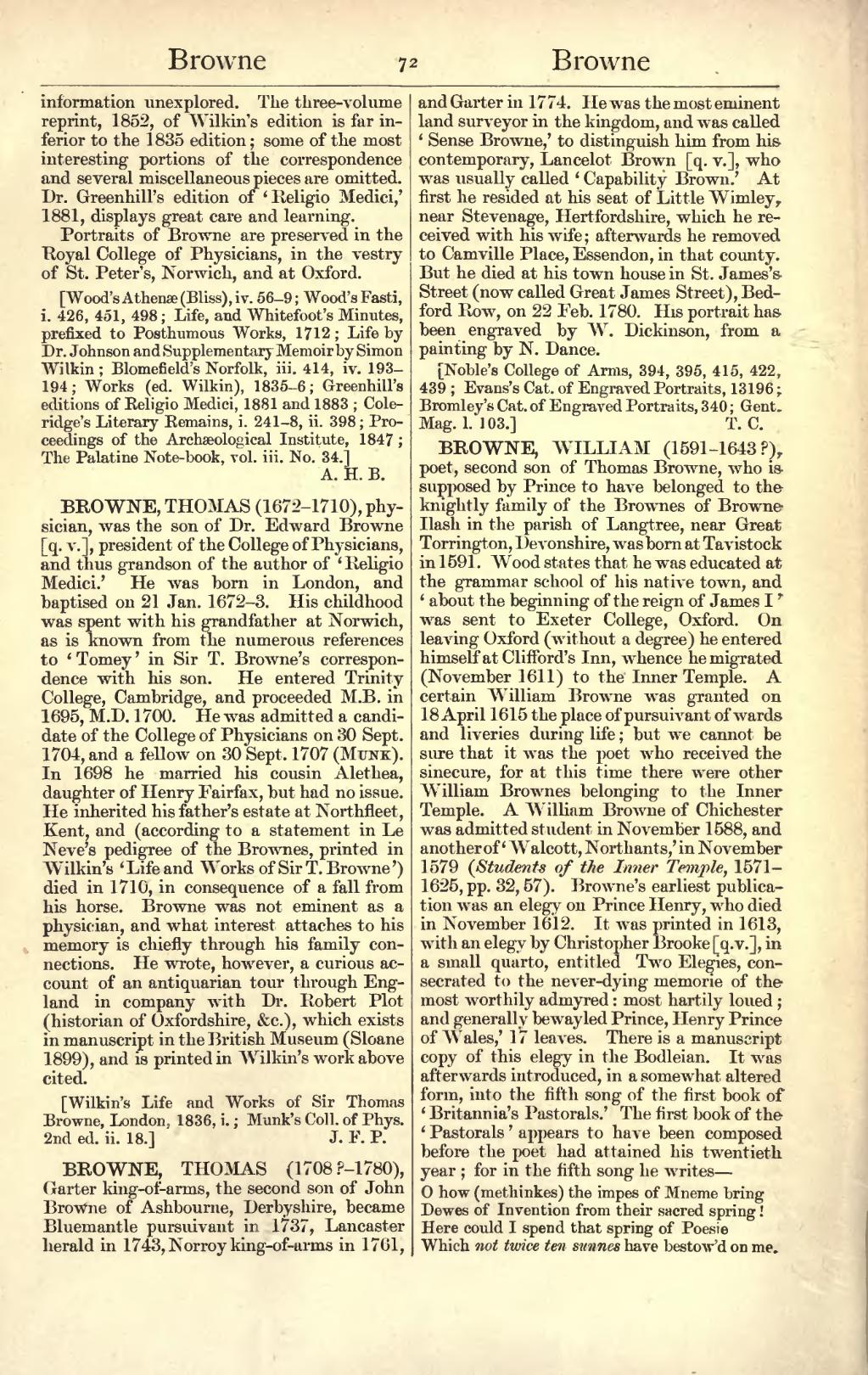information unexplored. The three-volume reprint, 1852, of Wilkin's edition is far inferior to the 1835 edition; some of the most interesting portions of the correspondence and several miscellaneous pieces are omitted. Dr. Greenhill's edition of ‘Religio Medici,’ 1881, displays great care and learning.
Portraits of Browne are preserved in the Royal College of Physicians, in the vestry of St. Peter's, Norwich, and at Oxford.
[Wood's Athenæ (Bliss), iv. 56–9; Wood's Fasti, i. 426, 451, 498; Life, and Whitefoot's Minutes, prefixed to Posthumous Works, 1712; Life by Dr. Johnson and Supplementary Memoir by Simon Wilkin; Blomefield's Norfolk, iii. 414, iv. 193–194; Works (ed. Wilkin), 1835–6; Greenhill's editions of Religio Medici, 1881 and 1883; Coleridge's Literary Remains, i. 241–8, ii. 398; Proceedings of the Archæological Institute, 1847; The Palatine Note-book, vol. iii. No. 34.]
BROWNE, THOMAS (1672–1710), physician, was the son of Dr. Edward Browne [q. v.], president of the College of Physicians, and thus grandson of the author of 'Religio Medici.' He was born in London, and baptised on 21 Jan. 1672-3. His childhood was spent with his grandfather at Norwich, as is known from the numerous references to 'Tomey' in Sir T. Browne's correspondence with his son. He entered Trinity College, Cambridge, and proceeded M.B. in 1695, M.D. 1700. He was admitted a candidate of the College of Physicians on 30 Sept. 1704, and a fellow on 30 Sept. 1707 (Munk). In 1698 he married his cousin Alethea, daughter of Henry Fairfax, but had no issue. He inherited his father's estate at Northfleet, Kent, and (according to a statement in Le Neve's pedigree of the Brownes, printed in Wilkin's 'life and Works of Sir T. Browne') died in 1710, in consequence of a fall from his horse. Browne was not eminent as a physician, and what interest attaches to his memory is chiefly through his family connections. He wrote, however, a curious account of an antiquarian tour through England in company with Dr. Robert Plot (historian of Oxfordshire, &c.), which exists in manuscript in the British Museum (Sloane 1899), and is printed in Wilkin's work above cited.
[Wilkin's Life and Works of Sir Thomas Browne, London, 1836, i.; Munk's Coll. of Phys. 2nd ed. ii. 18.]
BROWNE, THOMAS (1708?–1780), Garter king-of-arms, the second son of John Browne of Ashbourne, Derbyshire, became Bluemantle pursuivant in 1737, Lancaster herald in 1743, Norroy king-of-arms in 1761, and Garter in 1774. He was the most eminent land surveyor in the kingdom, and was called 'Sense Browne,' to distinguish him from his contemporary, Lancelot Brown [q. v.], who was usually called 'Capability Brown.' At first he resided at his seat of Little Wimley near Stevenage, Hertfordshire, which he received with his wife; afterwards he removed to Camville Place, Essendon, in that county. But he died at his town house in St. Jameses Street (now called Great James Street), Bedford Row, on 22 Feb. 1780. His portrait has been engraved by W. Dickinson, from a painting by N. Dance.
[Noble's College of Arms, 394, 395, 415, 422, 439; Evans's Cat. of Engraved Portraits, 13196; Bromley's Cat. of Engraved Portraits, 340; Gent. Mag. l. 103.]
BROWNE, WILLIAM (1591–1643?), poet, second son of Thomas Browne, who is supposed by Prince to have belonged to the knightly family of the Brownes of Browne Hash in the parish of Langtree, near Great Torrington, Devonshire, was born at Tavistock in 1591. Wood states that he was educated at the grammar school of his native town, and 'about the beginning of the reign of James I' was sent to Exeter College, Oxford. On leaving Oxford (without a degree) he entered himself at Clifford's Inn, whence he migrated (November 1611) to the Inner Temple. A certain William Browne was granted on 18 April 1615 the place of pursuivant of wards and liveries during life; but we cannot be sure that it was the poet who received the sinecure, for at this time there were other William Brownes belonging to the Inner Temple. A William Browne of Chichester was admitted student in November 1588, and another of 'Walcott, Northants,' in November 1579 (Students of the Inner Temple, 1571-1625, pp. 32, 57). Browne's earliest publication was an elegy on Prince Henry, who died in November 1612. It was printed in 1613, with an elegy by Christopher Brooke [q. v.], in a small quarto, entitled Two Elegies, consecrated to the never-dying memorie of the most worthily admirred most hartily loued; and generally bowayled Prince, Henry Prince of Wales,' 17 leaves. There is a manuscript copy of this elegy in the Bodleian. It was afterwards introduced, in a somewhat altered form, into the fifth song of the first book of 'Britannia's Pastorals.' The first book of the 'Pastorals' appears to have been composed before the poet had attained his twentieth year; for in the fifth song he writes—
O how (methinkes) the impes of Mneme bring
Dewes of Invention from their sacred spring!
Here could I spend that spring of Poesie
Which not twice ten sunnes have bestow'd on me.
